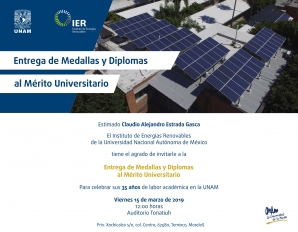Mostrando artículos por etiqueta: 2020 publication
Development of an Elevation–Fresnel Linked Mini-Heliostat Array
Isaías Moreno-Cruz,Juan Carlos Castro,Omar Álvarez-Brito,Hilda B. Mota-Nava,Guillermo Ramírez-Zúñiga,José J. Quiñones-Aguilar and Camilo A. Arancibia-Bulnes
Abstract
Heliostats are critical components of solar tower technology and different strategies have been proposed to reduce their costs; among them diminishing their size to reduce wind loads or linking nearby heliostats mechanically, to reduce the overall number of actuators. This document aims to describe the development of a linked array of mini-heliostats which move together in an elevation–Fresnel configuration. This configuration consists of an array of mirrors rotating around linked parallel axes, in a linear Fresnel style with an added elevation mechanism allowing all axes to incline simultaneously in the plane North–South–Zenith; that is equivalent to an array of N linked mini-heliostats moved by only two drives instead of 2N. A detailed analytical study of the Sun-tracking performance of this kind of heliostat arrays was carried out, and an 8-mirror prototype based on optical and mechanical analyses was designed, built and tested. Even though the mirrors are flat, the array produced a rather compact radiative flux distribution on the receiver. The flux distribution is compatible with a slope error of the order of 1 mrad. Peak and mean concentration ratios reached 6.89 and 3.94, respectively
Development of an Elevation–Fresnel Linked Mini-Heliostat Array
Unraveling the mechanisms of lead adsorption and ageing process on high‐temperature biochar
Alfonso Encinas‐Vázquez, Javier Alan Quezada‐Renteria, Francisco J Cervantes, Carlos A Pérez‐Rábago, Francisco E Molina‐Freaner, Aurora M Pat‐Espadas, Claudio A Estrada
Abstract
The synthesis gas or hydrogen‐rich gas, at longer residence times and higher temperatures, is frequently the target of pyrolysis biomass. Biochars obtained at such conditions contain less functional groups but they are more effective for longer‐term soil C storage. The aim of this study was to elucidate the adsorption mechanisms and the effect of the ageing process on high‐temperature biochar towards lead adsorption. The biochars under study were produced from the pyrolysis of almond wood and olive tree pruning.
The almond hardwood biochar was the most susceptible to the oxidation process. This biochar exhibited higher carbon loss than the olive biochar, 22.07% and 11.76%, respectively. The adsorption process was better described by the Langmuir model and pseudo‐second order kinetics. The maximum adsorption capacity decreased from 40.3 to 24.8 mg g–1 after the oxidation process for almond‐derived biochar and remained unchanged for the olive‐biochar. Analyses demonstrated that 67% of the adsorbed Pb2+ was removed through complexation by oxygen functionalities and phosphorous compounds. After the oxidation process, this fraction accounted for only 45% of the adsorbed Pb2+, ion exchange and cation‐π being the most prominent mechanisms for the adsorption.
Unraveling the mechanisms of lead adsorption and ageing process on high‐temperature biochar

